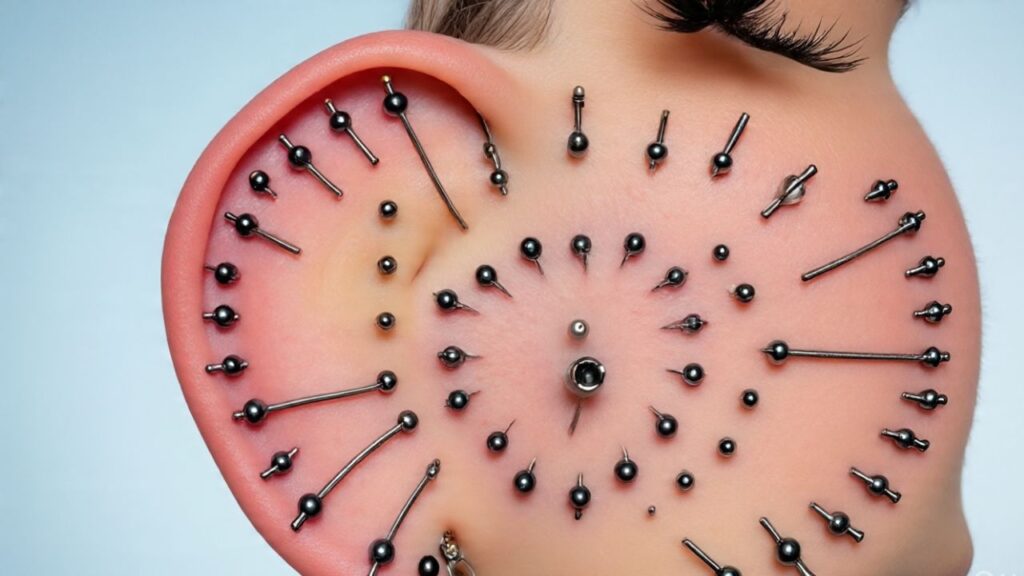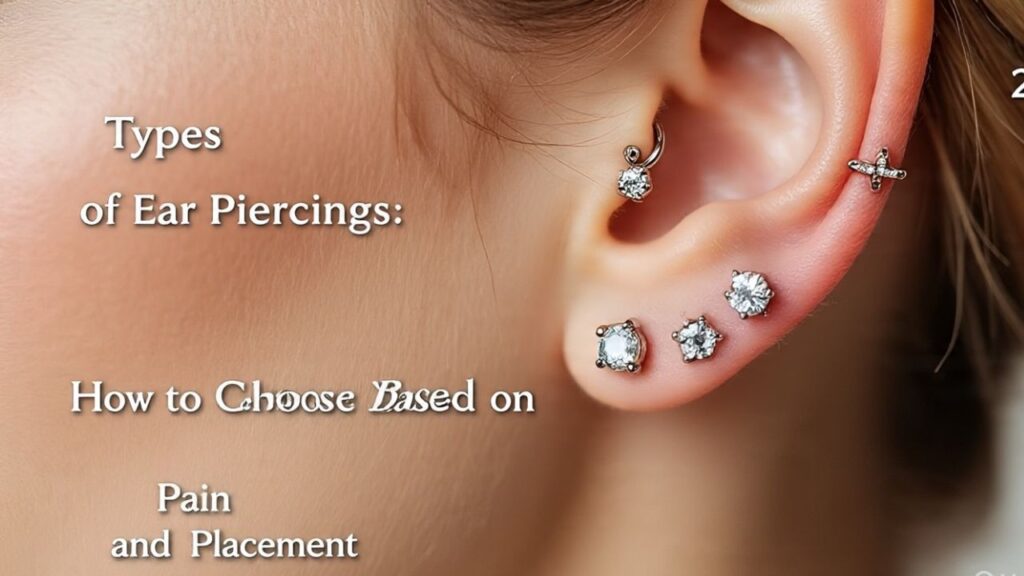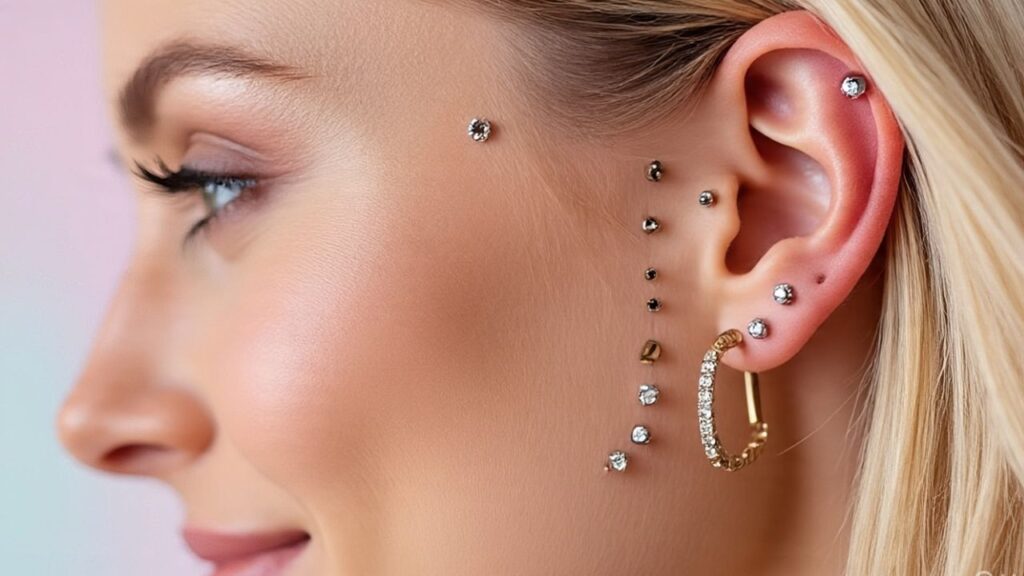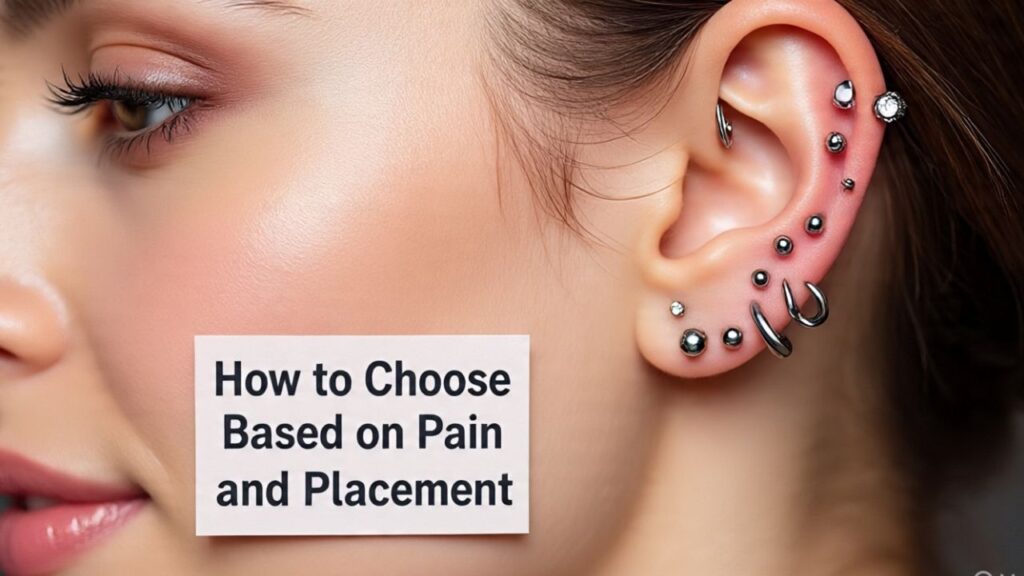Ear Piercings is a simple and trendy way to express your personality. Each type of piercing has its own pain level, healing time, and unique look. In this guide, you’ll discover 20 popular ear piercing options to help you choose the one that suits you best.
Types of Ear Piercings
There are many types of ear piercings, each different in style, placement, and overall look. The most common options include lobe, helix, tragus, conch, rook, daith, and industrial piercings. Every piercing has its own unique vibe, pain level, and healing time. Whether you go for a simple lobe piercing or a bold cartilage piercing, each one is a stylish way to express your personality.
What Are the Different Types of Ear Piercings?
When it comes to ear piercings, the most popular choices are earlobe piercing (beginner-friendly), helix piercing (outer cartilage), tragus piercing (near the ear canal), and conch piercing (inner ear cartilage).
In recent years, trendy options like daith, rook, and flat piercings have also become popular. Each type creates a unique look that can be matched with your face shape and jewelry style.
How to Choose the Right Ear Piercing for You
To choose the right ear piercing, you should consider your pain tolerance, healing time, lifestyle, and personal style. For beginners, earlobe piercings are the best choice since they are less painful and heal quickly.
If you want a bold and edgy look, you can go for industrial or conch piercings. For people working in professional environments, more subtle piercings like tragus or helix are a perfect option.
Ear Piercing Pain Chart: Least to Most Painful
Each piercing has a different pain level. Lobe piercings are considered the least painful and are ideal for beginners. Slightly higher pain is felt with helix and tragus piercings because they involve cartilage.
Piercings like industrial, snug, and rook are usually more painful and take longer to heal. By checking a piercing pain chart, you can easily decide which piercing matches your comfort level.
Lobe Piercing: Beginner-Friendly and Popular Choice

Lobe piercing is the most common and beginner-friendly type of ear piercing. It is placed on the soft lower part of the ear, making it less painful and quick to heal.
This piercing is versatile because you can wear studs, hoops, or dangly earrings, and it suits all styles and face shapes. That’s why it’s often the first choice for anyone new to piercings.
Upper Lobe Piercing: Simple Yet Stylish
The upper lobe piercing sits just above the standard lobe. It’s slightly closer to the cartilage but still considered low on pain and fast healing.
Many people pair an upper lobe piercing with a standard lobe piercing to create a layered look. It’s simple, stylish, and allows for creative jewelry combinations without being too bold.
Helix Piercing: Outer Rim Cartilage Piercing Guide
A helix piercing is placed along the outer upper rim of the ear cartilage. It’s trendy, elegant, and can be styled with hoops or barbells.
Since it goes through cartilage, it may hurt more than a lobe piercing and takes longer to heal. The helix piercing is a favorite for people who want a fashionable, modern look without going too extreme.
Forward Helix Piercing: Placement, Pain & Healing
A forward helix piercing is located on the front part of the upper ear cartilage, close to where the ear connects with the head. It’s a stylish option that can be done as a single, double, or even triple piercing for a bold look.
Since it’s a cartilage piercing, the pain is moderate and the healing time usually takes 3 to 6 months. With proper aftercare, it can become a standout feature of your ear styling.
Industrial Piercing: The Double Bar Look
An industrial piercing connects two holes in the upper ear cartilage with a single straight barbell. It’s often called the scaffold piercing and is known for its edgy, unique style.
Because it involves two piercings at once, the pain level is higher and the healing period can take 6 to 12 months. Industrial piercings are perfect for people who want a bold, alternative look.
Tragus Piercing: Small but Bold Ear Piercing
The tragus piercing is placed on the small flap of cartilage just outside the ear canal. Even though it’s small, it creates a bold and stylish statement.
The pain level is moderate, and the healing time is usually 3 to 6 months. Many people choose a tragus piercing because it’s subtle enough for everyday wear but still adds a unique touch to their ear jewelry collection.
Conch Piercing: Inner vs Outer Conch Explained

A conch piercing is placed in the middle part of the ear cartilage, also known as the “concha.” There are two types: inner conch piercing, which sits deep inside the ear and is usually styled with studs, and outer conch piercing, which is closer to the edge and looks great with hoops. The pain level is moderate to high since it’s cartilage, and the healing can take 6 to 12 months. It’s a versatile choice for people who want both subtle and bold jewelry options.
Daith Piercing: Trendy Style with Health Myths
The daith piercing goes through the innermost fold of the ear cartilage. It’s very trendy because of its unique placement and is usually styled with hoops or heart-shaped rings.
Some believe it helps with migraines or anxiety, but there’s no scientific proof—these are just popular myths. The pain level is moderate, healing takes around 6 to 9 months, and it’s a stylish option for a distinctive look.
Rook Piercing: Curved Cartilage Piercing Option
A rook piercing is done on the ridge of cartilage above the daith. It stands out because of its curved placement, which works best with small hoops or curved barbells.
Since it’s thick cartilage, the pain level is high, and healing may take up to 12 months. The rook piercing is less common, making it a great choice if you want something unique and eye-catching.
Snug Piercing: Unique but Painful Placement
The snug piercing goes through the inner rim of cartilage, between the inner and outer conch. It’s considered one of the most painful piercings because of the thick cartilage and its unusual placement.
Healing time is usually 6 to 12 months, and jewelry options are limited to small barbells or hoops. The snug piercing is rare but perfect for people who want a bold, standout look.
Orbital Piercing: Two Holes, One Ring Style
An orbital piercing connects two holes in the ear with a single ring. It’s commonly done on the lobe or cartilage, creating a stylish and modern look. The pain level depends on the placement—lobe orbital piercings are less painful, while cartilage orbitals can hurt more and take longer to heal. It’s a creative option for people who want something different from traditional piercings.
Flat Piercing: The Modern Ear Piercing Trend
The flat piercing is placed on the flat area of cartilage between the helix and rook. It has become a modern favorite because it looks sleek and allows for unique stud or gem jewelry. Pain level is moderate, and healing usually takes 6 to 8 months. The flat piercing is perfect for those who love minimalist but trendy ear styles.
Transverse Lobe Piercing: Horizontal Bar Placement
Unlike a regular lobe piercing, a transverse lobe piercing goes horizontally through the earlobe with a barbell. It creates a striking look but is less common than traditional piercings. Pain level is low since it’s still soft tissue, but healing may be tricky and take longer because of the piercing angle. This style is bold and great for anyone looking for something unique.
Which Ear Piercing Hurts the Most?
Pain depends on the thickness of the area being pierced. Lobe piercings are the least painful, while cartilage piercings like the helix, tragus, and conch cause more discomfort.
The most painful options are usually the industrial, snug, and rook piercings because they go through thick cartilage. Understanding pain levels helps you choose the right piercing for your comfort level.
Fastest Healing Ear Piercings for Beginners
If you’re new to piercings, it’s best to start with one that heals quickly. Lobe piercings are the fastest to heal, usually within 6 to 8 weeks. Upper lobe piercings also heal relatively quickly. Cartilage piercings such as helix or tragus take much longer—anywhere from 3 to 12 months. Beginners should stick to lobes for an easy and safe experience.
Best Jewelry Choices for Different Ear Piercings

Each piercing type looks best with certain jewelry. Lobe piercings work well with studs, hoops, or dangly earrings. Helix and cartilage piercings suit barbells or small hoops.
Daith and orbital piercings are usually styled with captive rings, while industrial piercings require a straight barbell. Choosing the right jewelry not only enhances style but also supports proper healing.
Risks, Safety Tips, and Aftercare for Ear Piercings
Like all body modifications, ear piercings come with risks such as infection, swelling, or irritation. To avoid complications, always get pierced by a professional piercer using sterile equipment.
Aftercare includes cleaning the piercing with saline solution, avoiding unnecessary touching, and not changing jewelry too early. Proper care ensures safe healing and keeps your piercing looking great.
Frequently Asked Questions
Do ear piercings hurt a lot?
Pain depends on the type—lobe piercings are mild, while cartilage piercings can be more painful.
How long does an ear piercing take to heal?
Lobe piercings usually heal in 6–8 weeks, while cartilage piercings may take 3–12 months.
Which ear piercing is best for beginners?
The earlobe piercing is best for beginners since it’s least painful and heals fast.
Can I sleep on my new ear piercing?
It’s better to avoid sleeping on fresh piercings to prevent irritation and infections.
What’s the safest way to care for a new piercing?
Clean with saline solution, avoid touching too much, and don’t change jewelry too early.
Conclusion
Ear piercings are more than just a fashion trend—they’re a way to express your personality and style. From simple lobe piercings to bold cartilage options, each type has its own charm, pain level, and healing time.
Whether you’re a beginner or looking to add something unique, the key is to choose a piercing that fits your comfort and lifestyle. With the right aftercare, your piercing will not only heal safely but also become a stylish part of your look.

Alexander Smith is an accomplished blogger with years of experience in crafting engaging and insightful content. Known for his expertise and passion for storytelling, Alexander brings a unique perspective to Fascinate Names, captivating readers with his thoughtful analysis and fresh ideas. His extensive background in digital media and writing makes him a valuable voice in the blogging community.







